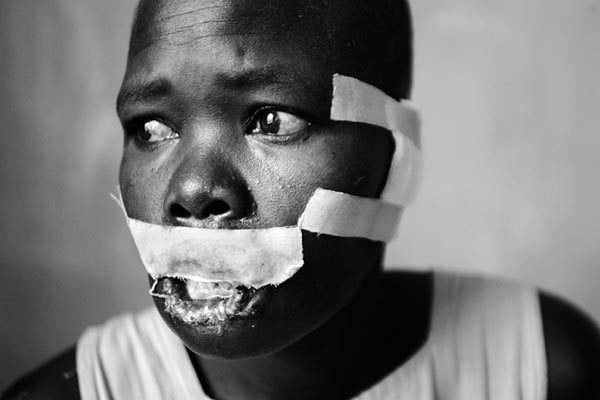The Sacred Band of Thebes was an elite combat force in the ancient Greek city of Thebes. Soldiers were chosen from the citizen army and housed, and trained at the city's expense. The soldiers consisted of pedastric couples that consisted of an adult male and an adolescent boy. It was believed that lovers "would be ready to die a thousand deaths"<!–[if !supportFootnotes]–><!–[endif]–> rather than face defeat.
 The First Book of Samuel tells the story of a Philistine attack against the Israelites in the Valley of Elah. The Philistine champion, Goliath, taunted the Israelites to send a man to defeat him, or become subjects of the Philistine army. David, who would later be King, conscripted himself to fight the Philistine Goliath. David entered into battle with no armor or weapon, other than a sling, as there was no suitable accommodation for a child. The story alleges that David emerged victories from the battle, triumphantly beheading Goliath. David's age at the time is believed to be around fifteen.
The First Book of Samuel tells the story of a Philistine attack against the Israelites in the Valley of Elah. The Philistine champion, Goliath, taunted the Israelites to send a man to defeat him, or become subjects of the Philistine army. David, who would later be King, conscripted himself to fight the Philistine Goliath. David entered into battle with no armor or weapon, other than a sling, as there was no suitable accommodation for a child. The story alleges that David emerged victories from the battle, triumphantly beheading Goliath. David's age at the time is believed to be around fifteen.
Drummer boys, often younger than fourteen, were used in combat to set the pace for military advancement into theater. Accounts of the Battle of Waterloo depict French drummer boys leading Napoleon's army into battle, only to meet Allied gunners at the frontlines. The traditional choral of Young Edward tells the story of a young drummer boy who meets his death in the Battle of Waterloo;
We laid his head upon his drum
Beneath the moon like mournful dew,
The night was still, the battle hummed,
We dug his grave at Waterloo
Developments in international law have modernized dictums regarding the age of conscription and the general rights of children. The Geneva Conventions, adopted in 1977, assure in Protocol I, Article 77, Section 2 that all parties to conflict guarantee that "children who have not attained the age of fifteen years do not take a direct part in hostilities and, in particular, they shall refrain from recruiting them into their armed forces."<!–[endif]–> The United Nations Children Fund (UNICEF) outlines the Convention on the Rights of a Child, which echo the provisions of the Geneva Conventions. The Cape Town Principles adopted in 1997, through the efforts of UNICEF, formally rose the age of conscription to the age of eighteen. The Cape Town Principles "recommend actions to be taken by governments and communities in affected countries to end this violation of children's rights." Finally, in February, 2007, representatives of 58 countries gathered in Paris at the behest of UNICEF in order to urge "concrete action on the ground that protects children from recruitment and supports those already recruited to overcome their experiences and reenter their communities.”<!–[endif]–>
 According to Peter W. Singer, Senior Fellow at The Brookings Institute, the occurrence of child soldiers is far more prolific than typically conceived. Dr. Singer states that child soldiers "serve in 40% of the world's armed forces, rebel groups, and terrorist organizations and fight in almost 75% of the worlds conflicts." Dr. Singer notes in his book, Children at War, that children as young as ten-years of age are typically coerced into armed conflict by militant groups in Southeast Asia and Central Africa. The youngest child highlighted by Dr. Singer was an armed five-year old in Uganda.
According to Peter W. Singer, Senior Fellow at The Brookings Institute, the occurrence of child soldiers is far more prolific than typically conceived. Dr. Singer states that child soldiers "serve in 40% of the world's armed forces, rebel groups, and terrorist organizations and fight in almost 75% of the worlds conflicts." Dr. Singer notes in his book, Children at War, that children as young as ten-years of age are typically coerced into armed conflict by militant groups in Southeast Asia and Central Africa. The youngest child highlighted by Dr. Singer was an armed five-year old in Uganda.
Child soldiers are often abducted by militant forces and put into forced labor before beginning armed combat. They are often seen as serving a tactical advantage, as the value of life placed upon a child is high. For example, in mid March, 2007, US forces allowed a car to pass a check point with children in the backseat. The children were later left in the car as it was detonated by Iraqi insurgents. Regarding combat, children are typically drugged to inhibit reluctance and induced to continue service through various propaganda techniques, such as fear and family vengeance.
 Los Angeles Times photographer, Francis Orr has highlighted the atrocities committed by child soldiers in the Lords Resistance Army (LRA) in Uganda. Ms. Orr reported from Uganda between 2003 and 2005. Her photo essays depict the horrific acts committed by child soldiers of the LRA. In an August 9th, 2005 interview with NPR, Ms. Orr describes how the LRA abducted some 30-40,000 children, using the boys as soldiers and the girls as sex slaves. Her story highlights how the LRA would use the tactic of "cutting" to punish transgressors. Ms. Orr relays the account of Lokeria Aciro. Lokeria had tried to escape the LRA on foot. When she was captured, she had her lips and ears cut off by an eleven year old boy.
Los Angeles Times photographer, Francis Orr has highlighted the atrocities committed by child soldiers in the Lords Resistance Army (LRA) in Uganda. Ms. Orr reported from Uganda between 2003 and 2005. Her photo essays depict the horrific acts committed by child soldiers of the LRA. In an August 9th, 2005 interview with NPR, Ms. Orr describes how the LRA abducted some 30-40,000 children, using the boys as soldiers and the girls as sex slaves. Her story highlights how the LRA would use the tactic of "cutting" to punish transgressors. Ms. Orr relays the account of Lokeria Aciro. Lokeria had tried to escape the LRA on foot. When she was captured, she had her lips and ears cut off by an eleven year old boy.
 Red Hand Day is February 12th. It is an annual commemoration initiated in 2002 at the invocation of the Optional Protocol to the Convention on the Rights of the Child on the Involvement of Children in Armed Conflict. Its purpose is a call to action to end the atrocity of child abuse in its most extreme form. The use of child soldiers is a horrific violation of humanity. Its employment is historic, long, and insufferable. Unfortunately, the story continues.
Red Hand Day is February 12th. It is an annual commemoration initiated in 2002 at the invocation of the Optional Protocol to the Convention on the Rights of the Child on the Involvement of Children in Armed Conflict. Its purpose is a call to action to end the atrocity of child abuse in its most extreme form. The use of child soldiers is a horrific violation of humanity. Its employment is historic, long, and insufferable. Unfortunately, the story continues.
<!–[if !supportFootnotes]–>
_________________________
<!–[if !supportFootnotes]–>
<!–[if !supportFootnotes]–>